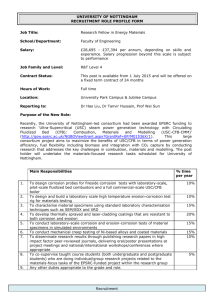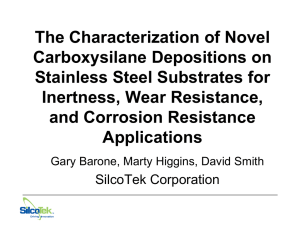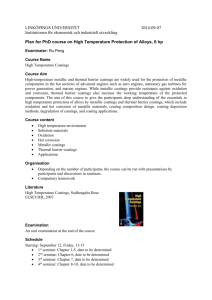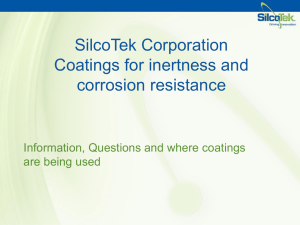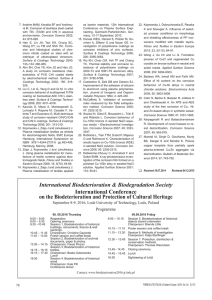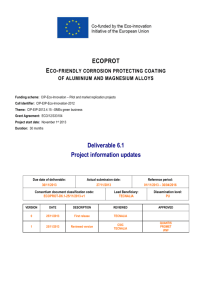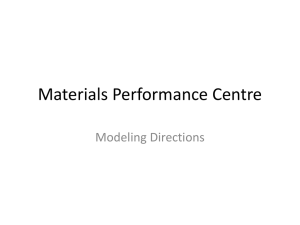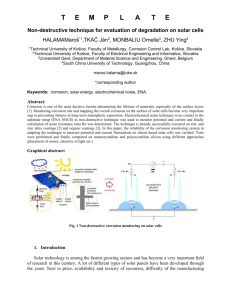Why use coatings?
advertisement
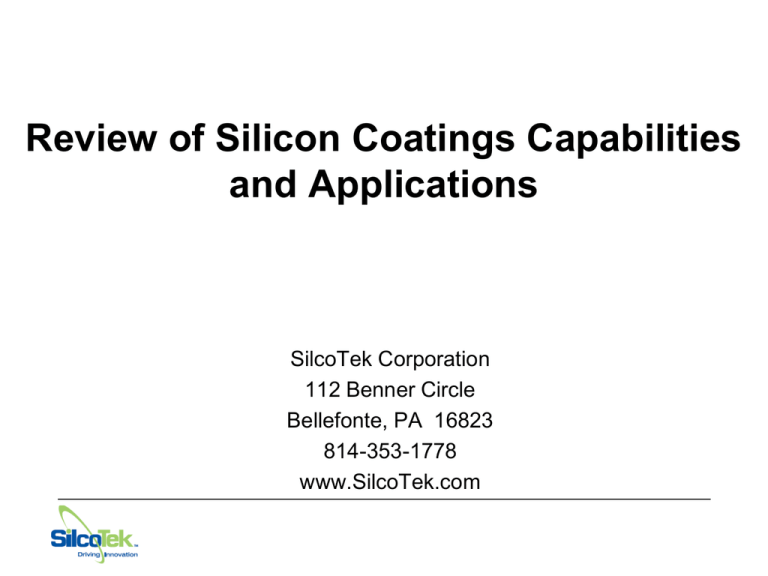
Review of Silicon Coatings Capabilities and Applications SilcoTek Corporation 112 Benner Circle Bellefonte, PA 16823 814-353-1778 www.SilcoTek.com Overview • Background: – About silicon coatings, CVD process and capabilities • Comparative Testing, Benefits, Applications • Inertness and Sulfur • Corrosion resistance • Anti-coking • Purity/Ultra high vacuum • Questions Why use coatings? • Reduce loss of active compounds – – – – – Avoid false negatives Sulfur compounds quickly lost without coatings Improved sample transfer Sample stable from field to lab Avoid loss of sample due to adsorption • Sulfur • Mercury – Immediate response during process changes – Creates savings when used in feedback monitors – Reduces moisture contamination effects No Loss during storage! • • • • Reduces adsorption effects Improves analytical reliability Faster cycle times and increased accuracy – 17ppbv H2S Containment in 500ml Cylinders (H2S to DMS) RRF 2 1.8 1.6 1.4 1.2 1 Coated/functionalized steel cylinders 0.8 0.6 0.4 Uncoated steel cylinders 0.2 0 1 2 3 Day 6 7 No transfer Loss! Reduce sample adsorption by 98% Improve Process Response Improve Yield Mercury stable during storage! Average Mercury Concentration (ug/m 3) Average Mercury Response Comparison of Stainless Steel vs. Silicon Functionalized Surfaces 7 6 5 4 3 2 1 0 0 10 20 30 40 50 Days after fill Untreated cylinders (n=2) Functionalized cylinders (n=2) 60 SilcoNert 2000 Advantages • Most inert coating available • • • • High Temperature Durable/flexible/high tolerance Enable testing in rugged environment Allows user to modify surface without redesign/remanufacture SilcoNert 2000 & Dursan Applications Sulfur contaminants, CO2 NOx and SOx from coal plants Sulfur emissions, refinery flares Mercury emissions, coal and gas Ethylene/propylene feedstock testing Water quality testing, headspace + purge and trap Exhaust, stack emissions, ammonia Toxic organics, whole air monitoring Defense security, chemical warfare agents, explosives Low moisture sampling and control GC testing of active compounds Oil and gas, downhole, transport and refinery sampling Why use coatings? • Corrosion resistance – Prolong component life • Salt water environments (platforms) • Chemical process industry • Refining – Save money by avoiding use of chrome/moly or highnickel alloys for: • Chloride exposure • Produced water • Instrumentation – Some coatings offer both corrosion and inertness 2 Corrosion Resistant Coatings • Silcolloy 1000 – Silicon, up to ½ um thick – Semiconductor, purity • Dursan – Silicon, carbon, oxygen, 1/2um + thick – High durability, greater corrosion resistance Wear Resistance Comparison Pin on Disc; 2.0N 316 SS Silicon Carboxysilane Wear rate (x10-5mm3/N m) 13.810 15.344 6.129 Improvement Factor over --- 0.9 X 2X Stainless Steel •CSM Instruments •Tribometer 18-343 used to measure surface wear resistance Acid Corrosion Resistance • ASTM G31 Guidelines: 6M HCl; 24hr; 23ºC MPY Improvement Factor over 316L stainless 316L SS Silcolloy Dursan 181.98 4.32 0.44 --- 42 411 •SiCO coated •Photo after 19hr •exposure Comparative Corrosion Resistance • 10% H2SO4; 24hr; 22ºC ASTM G31 316L SS Silcolloy Dursan MPY 22.35 2.52 2.42 Improvement Factor --- 8.9 9.9 over 316L stainless Base Corrosion Resistance • ASTM G31 Guidelines: 1M KOH; 24hr; 22ºC MPY 316L SS Silcolloy Dursan 0 3.40 0.01 -- -- 261 Improvement Factor Over a-Silicon Chemical Inertness •Dursan coated Hydrophobic Properties •Krüss K100 Tensiometer 304 SS •Testing on •304 SS Advancing 36.0 •¼” OD tubing Receding 5.3 304 SS Silcolloy SilcoNert SN 1000 PTFE 1000 2000 Dursan Plate 53.6 87.3 105.5 125.4 19.6 51.5 85.3 84 SN 2000 Dursan Materials Cost Comparison 80% estimated life cycle cost savings: a-Si vs. HP Alloy Dursan Advantages • Significantly improves material performance beyond exotic alloys • Improve SS acidic and basic corrosion resistance • 2X improvement in wear resistance • Inert, non reactive, non-adsorptive • Withstands temperature up to 450°C • Hydrophobicity and oleophobicity similar to Teflon surface Coating Advantages • Longer Life: – Extend lifetimes of equipment exposed to corrosive environments • Low Cost Material Option • Protection: – Protection of high value equipment • Inert: – Provide enhanced corrosion resistance to analytical equipment – Maintain inert sample pathway – More inert than Inconel, Hastelloy, or glass. Ideal for 10ppm levels or higher • High Temperature: – High temperature stability up to 1000°C Silcolloy & Dursan Applications Process streams Semiconductor corrosion (Silcolloy) Process sampling/Refinery Fasteners in Offshore/Marine, Drill bits Continuous Emissions Monitoring Equipment Off-shore drilling platform equipment Automotive Exhaust Produced water management Why use coatings? • • • • • Reduce coking and carbon fouling Extend maintenance cycle Improve equipment efficiency Reduce emissions Prevent system failures due to fouling Why use coatings? • High Purity – Reduce system contamination – Reduce moisture effects – Eliminate ion contamination – Reduce vacuum pump down time Conclusion • Coatings are available for a wide range of applications • Optimize based on desired property • Inertness • Corrosion Resistance • Anti-Coking • Purity • Ultimate benefit is superior performance – – – – – Analytical results Extend life Reduce labor and capital cost Improve efficiency Optimize material selection and cost performance
